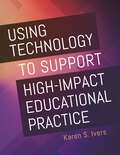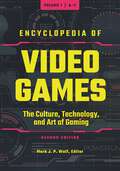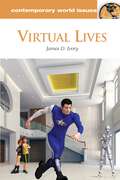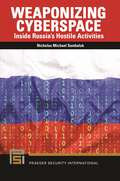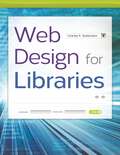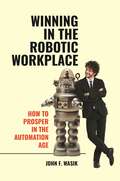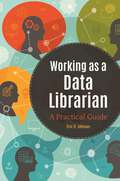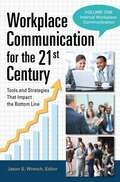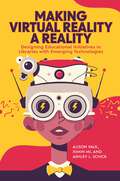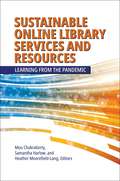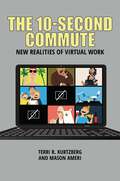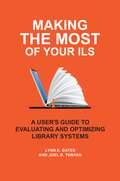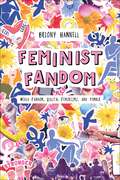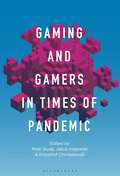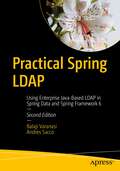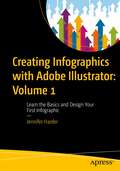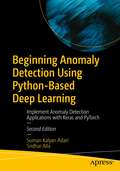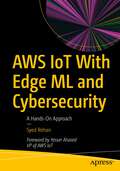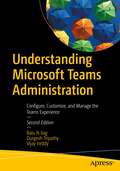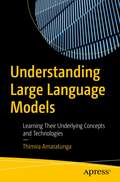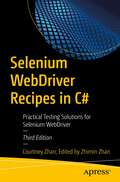- Table View
- List View
Using Technology to Support High-Impact Educational Practice
by Karen S. IversEmphasizing the importance of preparing students for the global workforce, this title explains how to teach using the latest educational technology.As technology becomes more advanced and accessible, it gives rise to new delivery methods of instruction and learning. High Impact Educational Practices including collaboration, diversity, global learning, service- and project-based learning, and research and writing, can be used to strengthen students' readiness for the demands of the 21st-century global community and workforce.This book helps current and future K–12 educators to better understand high impact educational practices and why they are important. It provides educators with ideas of how to use technology to support high impact educational practices in their classrooms and helps them to create just, equitable, and inclusive learning environments that support 21st-century learning.
Encyclopedia of Video Games [3 volumes]: The Culture, Technology, and Art of Gaming [3 volumes]
by Mark J. P. WolfNow in its second edition, the Encyclopedia of Video Games: The Culture, Technology, and Art of Gaming is the definitive, go-to resource for anyone interested in the diverse and expanding video game industry.This three-volume encyclopedia covers all things video games, including the games themselves, the companies that make them, and the people who play them. Written by scholars who are exceptionally knowledgeable in the field of video game studies, it notes genres, institutions, important concepts, theoretical concerns, and more and is the most comprehensive encyclopedia of video games of its kind, covering video games throughout all periods of their existence and geographically around the world.This is the second edition of Encyclopedia of Video Games: The Culture, Technology, and Art of Gaming, originally published in 2012. All of the entries have been revised to accommodate changes in the industry, and an additional volume has been added to address the recent developments, advances, and changes that have occurred in this ever-evolving field. This set is a vital resource for scholars and video game aficionados alike.
Virtual Lives: A Reference Handbook (Contemporary World Issues)
by James D. Ph.D.This book is the THE source for information on virtual worlds, covering every aspect of this intriguing and fast-changing social practice and the technologies upon which it rests.Virtual Lives: A Reference Handbook describes the history, development, and role of virtual worlds, also known as virtual environments and immersive virtual environments. It provides detailed background about virtual worlds and their societal impact, from early precursors and inspirations to the latest trends and developments. Specifics on user demographics are included, as are descriptions of virtual worlds' functions, discussion of societal concerns and opportunities, and information about relevant research data and key persons and organizations.Although virtual worlds in their current form are a relatively new phenomenon, other online social environments have served as precursors for decades and literary inspirations go back even further. This handbook therefore covers some early developments dating back to the mid-20th century. Its primary focus, however, is on developments since the mid-1990s and especially on the current state and social impact of virtual worlds, including their impact both in the United States and around the world.
Weaponizing Cyberspace: Inside Russia's Hostile Activities (Praeger Security International)
by Nicholas Michael SambalukThe Russian regime's struggle for internal control drives multifaceted actions in cyberspace that do not stop at national borders. Cybercrime, technical hacking, and disinformation are complementary tools to preserve national power internally while projecting effects onto myriad neighbors and rivals.Russian activity in the cyber domain is infamous in the United States and other Western countries. Weaponizing Cyberspace explores the Russian proclivity, particularly in the 21st century, for using cyberspace as an environment in which to launch technical attacks and disinformation campaigns that sow chaos and distraction in ways that provide short-term advantage to autocrats in the Kremlin.Arguing that Russia's goal is to divide people, Sambaluk explains that Russia's modus operandi in disinformation campaigning is specifically to find and exploit existing sore spots in other countries. In the U.S., this often means inflaming political tensions among people on the far left and far right. Russia's actions have taken different forms, including the sophisticated surveillance and sabotage of critical infrastructure, the ransoming of data by criminal groups, and a welter of often mutually contradictory disinformation messages that pollute online discourse within and beyond Russia. Whether deployed to contribute to hybrid war or to psychological fracture and disillusionment in targeted societies, the threat is real and must be understood and effectively addressed.
Web Design for Libraries
by Charles P. RubensteinHaving a clear, attractive, and easy-to-navigate website that allows users to quickly find what they want is essential for any organization—including a library. This workbook makes website creation easy—no HTML required.This book teaches all of the essentials for designing and creating a simple, professional-looking website for any library. By using cut-and-paste templates from familiar software programs, readers can create complex websites in short order—without learning confusing HTML coding. Three final chapters cover using style sheets, address the potential benefits of HTML5, and overview content management system based websites. By using this guidebook as a reference, even those without previous knowledge about web design will possess enough basic information to create a great web page—and, with a little practice, prepare a full library website.
Winning in the Robotic Workplace: How to Prosper in the Automation Age
by John F. WasikThis book will examine the history of robotics and explicate what massive automation means for the present and future of labor in all its forms, from mills and factories to the white-collars offices of suburbia and more.While warnings of a robot world-takeover could seem dramatic, the truth is more mundane—robots have come to take our jobs. Winning in the Robotic Workplace: How to Prosper in the Automation Age will teach you the skills needed to reprogram the way you work in anticipation of this technological shift. Author John F. Wasik believes learning to thrive in the automation age can in fact humanize the workplace once again. In Winning in the Robotic Workplace: How to Prosper in the Automation Age, you will learn to emphasize the conceptualization and pursuit of creative ideas, a practice that most robots are unequipped to perform in a meaningful way. You will learn that the successful integration of automated elements with humans is the most effective business model moving forward, and that an eagerness to collaborate demonstrates a will to succeed.
Working as a Data Librarian: A Practical Guide
by Eric O. JohnsonMany librarians' job responsibilities increasingly require them to understand and handle data. Learn how to be an effective data librarian—even if you never expected to need data skills.The field of data librarianship is rapidly growing, and some librarians may feel that their training and experience does not cover data questions asked by patrons seeking advice. With this gentle guide for librarians moving—sometimes unexpectedly—into the world of data librarianship, all you need is a willingness to learn the skills required for the rapidly growing number of jobs requiring data librarianship.Working as a Data Librarian focuses on transferable skills and understanding and does not assume extensive knowledge. It introduces tasks and concepts needed to be an effective data librarian, such as best practices for data reference interviewing, finding data sources, data visualization, data literacy, the data lifecycle, metadata design, database design, understanding data management, and preparing data management plans. Additional sections focus on supporting creativity (Makerspaces and Fablabs, 3-D modeling), supporting analysis (GIS, data visualization, text mining, statistical methods), supporting research (digital scholarship, digital preservation, institutional data repositories, scholarly communication), and outreach (data librarian liaisonship, hackathons, developing outreach programs).
Workplace Communication for the 21st Century [2 volumes]: Tools and Strategies That Impact the Bottom Line [2 volumes]
by Jason S. WrenchWritten in clear, non-technical language, this book explains how employees and employers can maximize internal and external organizational communication—for both personal benefit and to the entity as a whole.Workplace Communication for the 21st Century: Tools and Strategies That Impact the Bottom Line explains and simplifies what organizational communication scholars have learned, presenting this knowledge so that it can be easily applied to generate tangible benefits to employees and employers as they face everyday challenges in the real world.This two-volume work discusses internal organizational and external organizational communication separately, first explaining how communication functions within the confines of a modern organization, then addressing how organizations interact with various stakeholders, such as customers, clients, and regulatory agencies. The expert contributors provide a thorough and insightful view on organizational communication and supply a range of strategies that will be useful to practitioners and academics alike.
Making Virtual Reality a Reality: Designing Educational Initiatives in Libraries with Emerging Technologies
by Alison Valk Ximin Mi Ashley L. SchickWalks readers through the key components of developing library-led research and programming that leverages emerging technologies with the goal of engaging students and faculty.As educational curricula and research evolve to include advanced technologies, libraries must offer programming with these emerging technologies in mind, including the use of virtual reality (VR) and augmented reality (AR). In this timely guide, Valk, Mi, and Schick present readers with tools for assessing their level of organizational readiness to begin such programs and, more importantly, how to sustain them with limited budgets, expertise, and resources.Building on their own experiences, the authors teach readers how to develop technology-rich classes, assess student projects, and overcome technical hurdles. They spotlight this kind of programming as integral to building strategic partnerships in an educational environment. Readers will learn how to adapt and design programs or initiatives in which the necessary technologies are rapidly changing, not only in higher education institutions, but also in schools. Worksheets and resources assist readers in reflecting on their own work and developing educational programming to suit their organizational needs.
Sustainable Online Library Services and Resources: Learning from the Pandemic
by Mou Chakraborty, Samantha Harlow, and Heather Moorefield-LangCOVID-19 shifted library services and resources; this book includes narratives of lessons learned and sustainable practices to prepare educators and librarians for any challenges that might arise in the future.All different types of libraries (academic, public, special, and school) were impacted by the pandemic, and librarians learned valuable lessons about how to shift and transition in a challenging time.In this informative book, librarians, instructional designers, educators, and faculty from all over the world write about how they pivoted services and resources online to continue to serve patrons during a pandemic and beyond, as well as which services and programs will be sustainable and scalable. Online delivery of programs and services allows librarians to respond to many different situations, emergencies, and challenges, and this book is a record of the lessons that librarians learned and the practices they'll implement in the future based on their experiences with COVID-19. Sustainable Online Library Services and Resources showcases a diverse range of perspectives on how online learning has changed and grown with a focus on what library services and resources are here to stay.
The 10-Second Commute: New Realities of Virtual Work
by Terri R. Kurtzberg Mason AmeriVirtual work, which was steadily on the rise even before the pandemic, is explored in this timely book that describes the impact of technology on our work experiences, ranging from the individual psychological level to the broad societal implications.Widespread remote work is now possible, but it comes with its share of frustrations. Virtual work has changed our lives in ways big and small, from trying to balance our time to what we wear and where we sit and from how we communicate to where we should look during a videoconference. It's also fundamentally changed what kinds of jobs we can now do.Grounded in research and including lively personal anecdotes, The 10-Second Commute provides a thoughtful and comprehensive scan of the nature of virtual work. The authors, both researchers in management and technology, explore the current questions of our virtual lives, such as: Why Zoom instead of Skype? Why are emojis so useful? Why is videoconferencing so exhausting? How does diversity at work both help and hinder productivity? Virtual work is more than just work-it permeates our whole lives, and it will continue to do so as hybrid work arrangements become the new normal. Helping readers better understand the virtual work experience, this book will engage and inform everyone who is still trying to make it work.
Making the Most of Your ILS: A User's Guide to Evaluating and Optimizing Library Systems
by Lynn E. Gates Joel D. TonyanSystems administrators, librarians, and library staff will learn key principles and methods for securing their ILS and understand how to configure and optimize their library catalog by improving data management practices, streamlining existing workflows, and documenting their system's configuration.The integrated library system (ILS) plays a central role in every library's operations, but is your ILS optimized to ensure maximum productivity? Are you taking advantage of the features added since you implemented it? Walking readers through a wide-ranging ILS review, this book will help you ensure systems are properly configured, produce better documentation, and evaluate staff workflows.The authors-a director of collections and content and a director of user experience-created a comprehensive plan for reviewing an ILS, starting with planning the project and deciding whom to include. They discuss basic ILS security principles, including keeping patron data safe and the importance of reviewing staff permissions. After the basics, the authors go in-depth on reviewing codes and figuring out how different parts of an ILS work together as well as how to review those areas, and they offer ideas on how to stay up-to-date with your ILS, such as where to look for information on issues, updates, and new features. Several methods for analyzing and documenting workflows are also discussed.
Hideo Kojima: Progressive Game Design from Metal Gear to Death Stranding (Influential Video Game Designers)
by Bryan Hikari HartzheimAn exploration of the influential work of Hideo Kojima, creator of cinematic titles such as the blockbuster Metal Gear Solid franchise, which has moved over 50 million units globally, as well as Snatcher, Policenauts, and Death Stranding. As the architect of the Metal Gear Solid franchise, Kojima is synonymous with the “stealth game” genre, where tension and excitement is created from players avoiding enemies rather than confronting them. Through the franchise, Kojima also helped to bridge the gap between games and other forms of media, arguing that games could be deep experiences that unearthed complex emotions from players on the same level as films or novels. Drawing on archives of interviews in English and Japanese with Kojima and his team, as well as academic discourses of social/political games and cinematic narrative/world-building, this book examines Kojima's progressive game design as it applies to four key areas: socially-relevant narratives, cinematic aesthetics, thematically-connected systems, and reflexive spaces.
Hideo Kojima: Progressive Game Design from Metal Gear to Death Stranding (Influential Video Game Designers)
by Bryan Hikari HartzheimAn exploration of the influential work of Hideo Kojima, creator of cinematic titles such as the blockbuster Metal Gear Solid franchise, which has moved over 50 million units globally, as well as Snatcher, Policenauts, and Death Stranding. As the architect of the Metal Gear Solid franchise, Kojima is synonymous with the “stealth game” genre, where tension and excitement is created from players avoiding enemies rather than confronting them. Through the franchise, Kojima also helped to bridge the gap between games and other forms of media, arguing that games could be deep experiences that unearthed complex emotions from players on the same level as films or novels. Drawing on archives of interviews in English and Japanese with Kojima and his team, as well as academic discourses of social/political games and cinematic narrative/world-building, this book examines Kojima's progressive game design as it applies to four key areas: socially-relevant narratives, cinematic aesthetics, thematically-connected systems, and reflexive spaces.
Feminist Fandom: Media Fandom, Digital Feminisms, and Tumblr
by Briony HannellExamines how fannish and feminist modes of cultural consumption, production, and critique are converging and opening up informal spaces for young people to engage with feminism. Adopting an interdisciplinary theoretical framework and bringing together media and communications, feminist cultural studies, sociology, internet studies and fan studies, Hannell locates media fandom at the intersection of the multi-directional and co-constitutive relationship between popular feminisms, popular culture and participatory networked digital cultures. Feminist Fandom functions as an ethnographic account of how feminist identities are constructed, lived and felt through digital fannish spaces on the micro-blogging and social networking platform, Tumblr.
Feminist Fandom: Media Fandom, Digital Feminisms, and Tumblr
by Briony HannellExamines how fannish and feminist modes of cultural consumption, production, and critique are converging and opening up informal spaces for young people to engage with feminism. Adopting an interdisciplinary theoretical framework and bringing together media and communications, feminist cultural studies, sociology, internet studies and fan studies, Hannell locates media fandom at the intersection of the multi-directional and co-constitutive relationship between popular feminisms, popular culture and participatory networked digital cultures. Feminist Fandom functions as an ethnographic account of how feminist identities are constructed, lived and felt through digital fannish spaces on the micro-blogging and social networking platform, Tumblr.
Gaming and Gamers in Times of Pandemic
by Piotr SiudaThis edited collection brings in multiple scholarly perspectives to examine the impact of the pandemic and resulting government policies, especially lockdowns, on one particular cultural sphere: games.The COVID-19 pandemic has impacted virtually every aspect of our lives, regardless of where we live. In the initial months, many industry reports noted the unexpected positive impact on online digital game sales. Games were not just lockdown-proof, but boosted by lockdowns. Stay-at-home orders triggered a rush toward games as an alternative form of entertainment, and the ubiquity of mobile phones allowed wider than ever participation. Gaming and Gamers in Times of Pandemic studies how the COVID-19 pandemic affected game players, game developers, game journalists and game scholars alike in many other ways, starting with the most direct – illness, and sometimes death. Some effects are temporary, others are here to stay.
Gaming and Gamers in Times of Pandemic
This edited collection brings in multiple scholarly perspectives to examine the impact of the pandemic and resulting government policies, especially lockdowns, on one particular cultural sphere: games.The COVID-19 pandemic has impacted virtually every aspect of our lives, regardless of where we live. In the initial months, many industry reports noted the unexpected positive impact on online digital game sales. Games were not just lockdown-proof, but boosted by lockdowns. Stay-at-home orders triggered a rush toward games as an alternative form of entertainment, and the ubiquity of mobile phones allowed wider than ever participation. Gaming and Gamers in Times of Pandemic studies how the COVID-19 pandemic affected game players, game developers, game journalists and game scholars alike in many other ways, starting with the most direct – illness, and sometimes death. Some effects are temporary, others are here to stay.
Practical Spring LDAP: Using Enterprise Java-Based LDAP in Spring Data and Spring Framework 6
by Balaji Varanasi Andres SaccoThis revised edition is your practical, hands-on guide to developing Java-based enterprise applications with big data or batches of data using the Spring LDAP and the Spring Data LDAP frameworks. The book covers these popular Spring project modules and explains the purpose and fundamental concepts of LDAP before giving a comprehensive tour of the latest version of Spring LDAP and Spring Data LDAP as found in Spring Framework 6. The book provides a detailed treatment of LDAP controls and the new features of Spring LDAP such as Object Directory Mapping and LDIF parsing. LDAP has become the de facto standard for storing and accessing information in enterprises. Despite its widespread adoption, developers often struggle when it comes to using this technology effectively. The traditional Java LDAP and JNDI approaches have proven to be painful and have resulted in complex, less modular applications. The Spring LDAP framework provides an ideal alternative.After reading and using this book, you'll come away with a level of comfort for working with large batches of data or big data in your enterprise Spring applications development.What You'll LearnExplore "What is Java LDAP?" and understand the Spring LDAP and Spring Data LDAP frameworksSearch LDAP resourcesSort and page your LDAP resultsDive into object directory mappingHandle LDAP transactions and moreWho This Book Is ForIntermediate to advanced Java and Spring software developers; programmers with at least some prior experience in Java, especially the Spring Framework
Creating Infographics with Adobe Illustrator: Learn the Basics and Design Your First Infographic
by Jennifer HarderThis full-color book will teach you how to use Adobe Illustrator's various tools to create infographics, as well as basic page layouts for them. This is the first of three volumes which will cover all the fundamentals of Illustrator, an industry standard application used by graphic designers and marketing and communication teams. How is an infographic different from a logo or any other illustration? What additional thought processes, skills, or software tools should be utilized to create an infographic? In this first volume of Illustrator Basics, you will learn the answers to all these questions. Author Jennifer Harder will walk you through creating basic infographics in Illustrator using Basic Shape tools, Pen Tools, Type Tools, and Symbols. Upon completing this volume, you will have an appreciation for how easy it is to design an infographic and discover how rudimentary shapes and colors can affect readability while conveying meaning to your audience. You will be able to use this knowledge to create your own infographics using Illustrator’s wide array of tools. Who This Book Is For Discover the tools within Illustrator that are ideal for creating basic infographicsDevelop a logo based upon a scanned sketchGain an understanding of different infographic layouts and the process of reviewing them with your client Who This Book Is For Beginner-level designers and others who are interested in learning the process of creating infographics for their company, the classroom, for a visual resume, an article in a magazine, or a webpage.
Beginning Anomaly Detection Using Python-Based Deep Learning: Implement Anomaly Detection Applications with Keras and PyTorch
by Suman Kalyan Adari Sridhar AllaThis beginner-oriented book will help you understand and perform anomaly detection by learning cutting-edge machine learning and deep learning techniques. This updated second edition focuses on supervised, semi-supervised, and unsupervised approaches to anomaly detection. Over the course of the book, you will learn how to use Keras and PyTorch in practical applications. It also introduces new chapters on GANs and transformers to reflect the latest trends in deep learning. Beginning Anomaly Detection Using Python-Based Deep Learning begins with an introduction to anomaly detection, its importance, and its applications. It then covers core data science and machine learning modeling concepts before delving into traditional machine learning algorithms such as OC-SVM and Isolation Forest for anomaly detection using scikit-learn. Following this, the authors explain the essentials of machine learning and deep learning, and how to implement multilayer perceptrons for supervised anomaly detection in both Keras and PyTorch. From here, the focus shifts to the applications of deep learning models for anomaly detection, including various types of autoencoders, recurrent neural networks (via LSTM), temporal convolutional networks, and transformers, with the latter three architectures applied to time-series anomaly detection. This edition has a new chapter on GANs (Generative Adversarial Networks), as well as new material covering transformer architecture in the context of time-series anomaly detection. After completing this book, you will have a thorough understanding of anomaly detection as well as an assortment of methods to approach it in various contexts, including time-series data. Additionally, you will have gained an introduction to scikit-learn, GANs, transformers, Keras, and PyTorch, empowering you to create your own machine learning- or deep learning-based anomaly detectors. What You Will Learn Understand what anomaly detection is, why it it is important, and how it is appliedGrasp the core concepts of machine learning.Master traditional machine learning approaches to anomaly detection using scikit-kearn.Understand deep learning in Python using Keras and PyTorchProcess data through pandas and evaluate your model's performance using metrics like F1-score, precision, and recallApply deep learning to supervised, semi-supervised, and unsupervised anomaly detection tasks for tabular datasets and time series applications Who This Book Is For Data scientists and machine learning engineers of all levels of experience interested in learning the basics of deep learning applications in anomaly detection.
AWS IoT With Edge ML and Cybersecurity: A Hands-On Approach
by Syed RehanIn an era where the fusion of connectivity and technology is redefining industries, this book is a must-have guide for aspiring technologists and seasoned professionals alike. This meticulously crafted handbook guides you through every aspect of AWS IoT, touching upon vital spheres such as edge computing, machine learning, and industrial IoT, with a distinct spotlight on cybersecurity. Over the course of this book, industry veteran Syed Rehad unveils the secrets to setting up your AWS IoT environment and walks you through advanced concepts such as leveraging MQTT, mastering Digital Twin implementation, and plumbing the depths of edge machine learning. Whether you're experimenting with virtual devices or hands-on with Raspberry Pi setups, this book will steer you towards innovation and a transformative journey where technology meets intelligence and security, all under the expansive umbrella of AWS IoT. What You Will Learn AWS Mastery: Dive deep into AWS IoT essentials, from setup to hands-on SDK toolsAdvanced Connectivity: Explore advanced MQTT features and the potential of AWS IoT Core MQTT clientsDevice Integration: Master AWS IoT device creation, connection, and deployment, blending the digital and physicalDigital Twin: Unleash IoT's future with AWS IoT device shadow, capitalizing on digital twin technologyDevice Management: Transform remote oversight using secure IoT tunnelling and innovative actionsEdge Development: Merge IoT and Machine Learning via AWS IoT Greengrass, spotlighting image classificationData to Insights: Swiftly move from raw data to actionable insights leveraging Amazon TimestreamIoT Cybersecurity: Strengthen your defenses using AWS IoT Device Defender, Zero Trust principles, and Machine Learning (ML) Detect to prepare for and counter threats Who This Book Is For IoT developers and enthusiasts, professionals who want to implement IoT solutions in industrial scenarios, system architects and designers interested in edge machine learning, business intelligence analysts, and cybersecurity professionals.
Understanding Microsoft Teams Administration: Configure, Customize, and Manage the Teams Experience
by Balu N Ilag Durgesh Tripathy Vijay IreddyThis book provides solutions, best practices, tips, and workarounds to plan, design, customize, implement, and manage Microsoft Teams in any environment. This revised edition has been updated to reflect all the latest techniques and products, including migration from Skype for Business On-Prem to Microsoft Teams, along with Teams for Education, which includes a range of features and tools that enable teachers and students to collaborate, communicate, and learn in a virtual environment.The book begins with an overview of Microsoft Teams, including its architecture, teams/channels, audio/video meetings, and the phone system. The authors then take you deeper into deployment and management of teams, clients, guests and external access, and live events, followed by a walk-through of network assessment and bandwidth planning for Teams. Here, you will learn about deployment of quality of service and how to configure your phone systems using direct routing and calling plans. Moving forward, you will learn Microsoft Teams administration and policy management along with the migration process of Skype from Business On-Prem to Microsoft Teams. To wrap things up, the authors demonstrate some troubleshooting techniques for call quality issues in Teams, and walk you through various features of Teams for Education and how to utilize them. By the time you turn the last page of Understanding Microsoft Teams Administration, you'll be fully equipped to configure, customize, and control Teams with confidence. Don't just adapt to the future of collaboration—lead it. What You Will Learn Kickstart your journey: Get acquainted with the Teams architecture, from teams and channels to audio/video conferencing and beyondMaster the mechanics: Dive deep into deployment, including crucial aspects like guest access, such as events, and network assessmentElevate call quality: Learn the nuts and bolts of Quality of Service (QoS) and phone systems, including direct routing and calling plansAdmin like a pro: Gain insights into robust policy management, and understand how to navigate the Teams admin portal with finesseGet a grip on network assessment and bandwidth planning tailored specifically for TeamsUnlock secrets of quality of service, direct routing, and customized calling plansMigration simplified: Seamlessly shift from Skype for Business On-Prem to Teams without missing a beatEdu-tech unveiled: Explore Teams for Education and how its myriad features can enrich virtual learning experiences for teachers and students alikeWhat's new: A dedicated chapter exclusively covering Microsoft Teams for Education, focusing on empowering both educators and studentsWho This Book Is For Administrators and technical consultants focused on Microsoft Teams. This book serves as an invaluable resource for those looking to optimize team collaboration and communication within their organizations.
Understanding Large Language Models: Learning Their Underlying Concepts and Technologies
by Thimira AmaratungaThis book will teach you the underlying concepts of large language models (LLMs), as well as the technologies associated with them. The book starts with an introduction to the rise of conversational AIs such as ChatGPT, and how they are related to the broader spectrum of large language models. From there, you will learn about natural language processing (NLP), its core concepts, and how it has led to the rise of LLMs. Next, you will gain insight into transformers and how their characteristics, such as self-attention, enhance the capabilities of language modeling, along with the unique capabilities of LLMs. The book concludes with an exploration of the architectures of various LLMs and the opportunities presented by their ever-increasing capabilities—as well as the dangers of their misuse. After completing this book, you will have a thorough understanding of LLMs and will be ready to take your first steps in implementing them into your own projects. What You Will Learn Grasp the underlying concepts of LLMsGain insight into how the concepts and approaches of NLP have evolved over the yearsUnderstand transformer models and attention mechanismsExplore different types of LLMs and their applicationsUnderstand the architectures of popular LLMsDelve into misconceptions and concerns about LLMs, as well as how to best utilize them Who This Book Is For Anyone interested in learning the foundational concepts of NLP, LLMs, and recent advancements of deep learning
Selenium WebDriver Recipes in C#: Practical Testing Solutions for Selenium WebDriver
by Courtney ZhanSolve your Selenium WebDriver problems with this quick guide to automated testing of web applications with Selenium WebDriver in C#. This third edition contains hundreds of solutions to real-world problems, with clear explanations and ready-to-run Selenium test scripts that you can use in your own projects. Updated to Selenium version 4, this revision includes Visual Studio Code set up, additional recipes, and new chapters on Selenium DevTools and continuous testing. You'll see how to use Selenium WebDriver for select lists, navigation, assertions, frames, file upload and pop-up dialogs. You'll also learn how to locate web elements and test functions for hyperlinks, buttons, TextFields and TextAreas, radio buttons, CheckBoxes, and more. What You'll Learn Debug test scripts and test data Work with Selenium Remote Control Server Manage and deal with browser profiles and capabilities Monitor tests for advanced user interactions and experiences (UX) Who This Book Is For Experienced .NET and C# Windows application programmers/developers.
